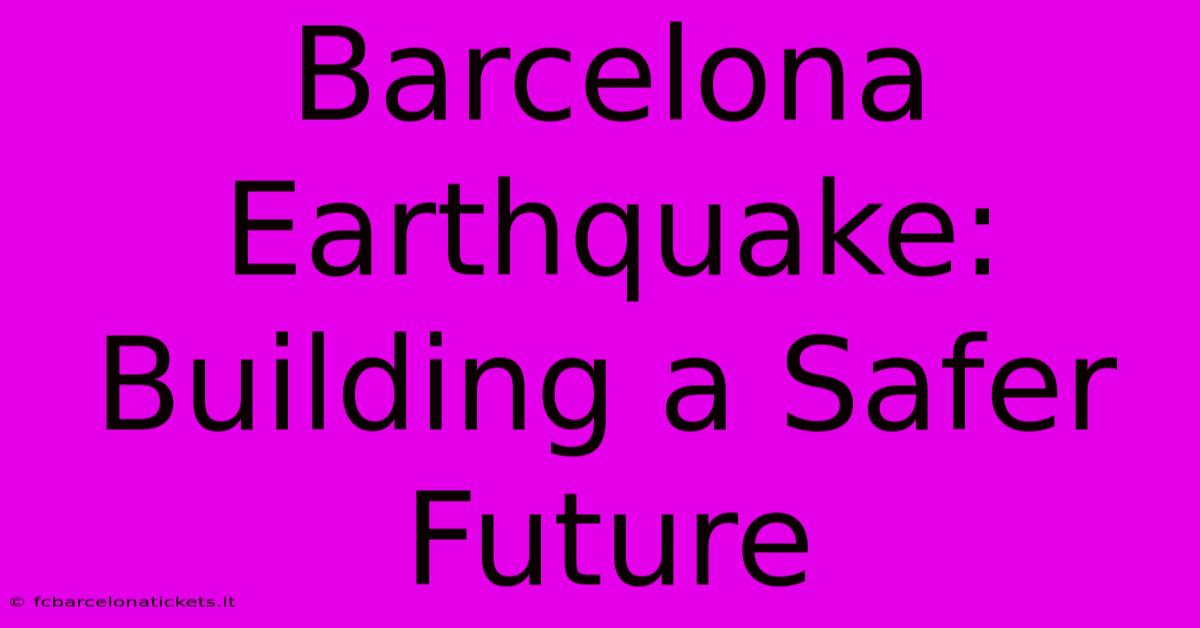Barcelona Earthquake: Building A Safer Future

Table of Contents
Barcelona Earthquake: Building a Safer Future
Barcelona, a city renowned for its vibrant culture and stunning architecture, sits on a geologically active region. While major earthquakes are infrequent, the potential for seismic activity remains a significant concern. The risk, though not immediate, demands proactive measures to ensure the safety and resilience of this beloved city. This article explores the seismic threat to Barcelona, examines existing building codes and preparedness measures, and proposes a path toward a more earthquake-safe future.
Understanding Barcelona's Seismic Risk
While not situated on a major fault line like California, Barcelona is located within the Iberian Peninsula, a region susceptible to earthquakes. Historically, significant tremors have impacted the area, albeit not with the frequency seen in other earthquake-prone regions. The potential for a moderate to strong earthquake, however, cannot be dismissed. Seismic hazard maps clearly indicate that parts of the city face a considerable risk, particularly older structures built before modern building codes were implemented.
Analyzing Past Seismic Events
Studying past earthquakes in the region is crucial for predicting future events. Analyzing the intensity, location, and impact of historical earthquakes helps seismologists understand the patterns and probabilities of future seismic activity in the Barcelona area. This data informs risk assessments and helps prioritize areas requiring more attention in terms of earthquake preparedness. Historical seismic data provides invaluable insights for developing more effective mitigation strategies.
Strengthening Building Codes and Infrastructure
Barcelona has made strides in strengthening its building codes to incorporate seismic design principles. However, the legacy of older buildings, constructed before these codes were implemented, presents a significant challenge. Retrofitting existing structures to withstand seismic forces is a complex and costly endeavor, but essential for reducing potential damage and casualties.
Modern Building Techniques for Seismic Resilience
Modern building techniques incorporate several key principles to enhance seismic resilience:
- Base Isolation: This technique involves decoupling the building's foundation from the ground, reducing the transmission of seismic waves to the structure.
- Ductile Concrete: Employing reinforced concrete that can bend and deform without fracturing is vital for absorbing seismic energy.
- Seismic Dampers: These devices are designed to dissipate seismic energy, mitigating the impact of ground shaking.
- Shear Walls and Bracing: These structural elements provide added strength and stability to withstand lateral forces from earthquakes.
Public Awareness and Emergency Preparedness
Public awareness is paramount in mitigating the impact of an earthquake. Educating citizens about earthquake safety procedures, emergency response plans, and the importance of having a family preparedness kit is crucial. Regular earthquake drills can help communities practice their response strategies and become more resilient to seismic events.
Developing Comprehensive Emergency Response Plans
A comprehensive emergency response plan is vital. This should include:
- Clear communication channels: Ensuring effective communication between emergency services, citizens, and local authorities.
- Evacuation routes and assembly points: Designating clear evacuation routes and designating safe assembly points for citizens to gather after an earthquake.
- Search and rescue teams: Establishing well-trained and equipped search and rescue teams capable of responding effectively.
- Medical support systems: Ensuring sufficient medical facilities and personnel are available to handle potential casualties.
Investing in Research and Monitoring
Ongoing research into seismic activity in the Barcelona region is crucial. Seismic monitoring networks provide real-time data, allowing for better prediction and response capabilities. Investing in advanced technologies and research initiatives will further enhance the city's ability to mitigate the risks posed by earthquakes.
Conclusion: Building a Safer Barcelona
Barcelona's journey towards a safer future requires a multi-pronged approach. Strengthening building codes, retrofitting existing structures, raising public awareness, developing comprehensive emergency plans, and investing in research are all critical components. By taking these steps proactively, Barcelona can significantly reduce its vulnerability to earthquakes and build a more resilient and safer city for generations to come. The collaborative efforts of engineers, policymakers, and citizens are essential to ensure the long-term safety and security of this beautiful city.

Thank you for visiting our website wich cover about Barcelona Earthquake: Building A Safer Future. We hope the information provided has been useful to you. Feel free to contact us if you have any questions or need further assistance. See you next time and dont miss to bookmark.
Featured Posts
-
Embrace Ageless Living Antiaging Group Barcelona
Apr 06, 2025
-
United Airlines Barcelona Enjoy A Hassle Free Terminal Experience
Apr 06, 2025
-
The Best Road Trip In Europe Barcelona To Nice
Apr 06, 2025
-
The Perfect European Cruise Barcelona To London
Apr 06, 2025
-
Sell Your Barcelona Property Get Started Today
Apr 06, 2025
